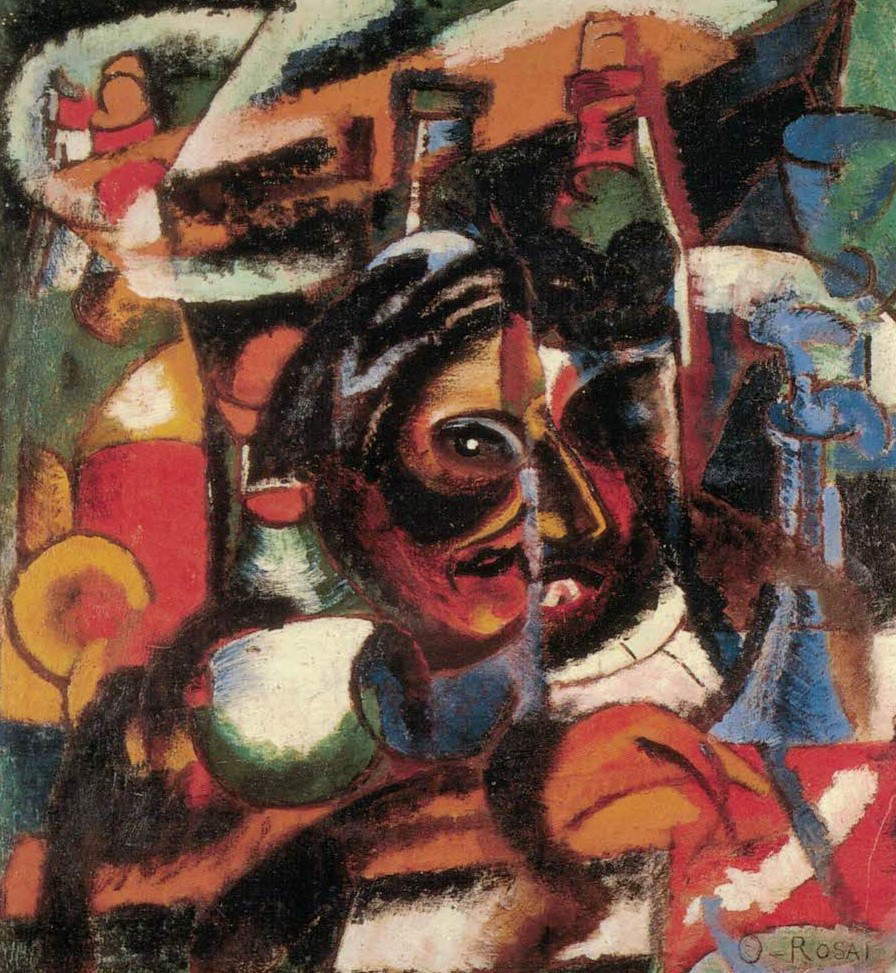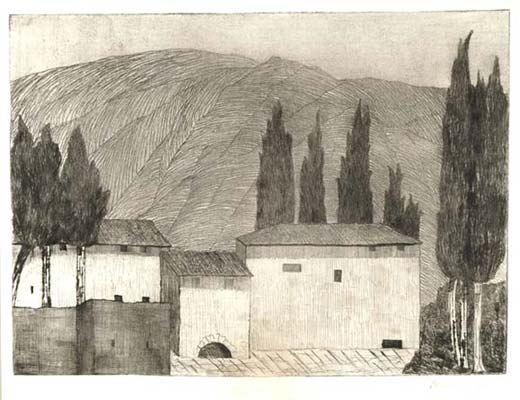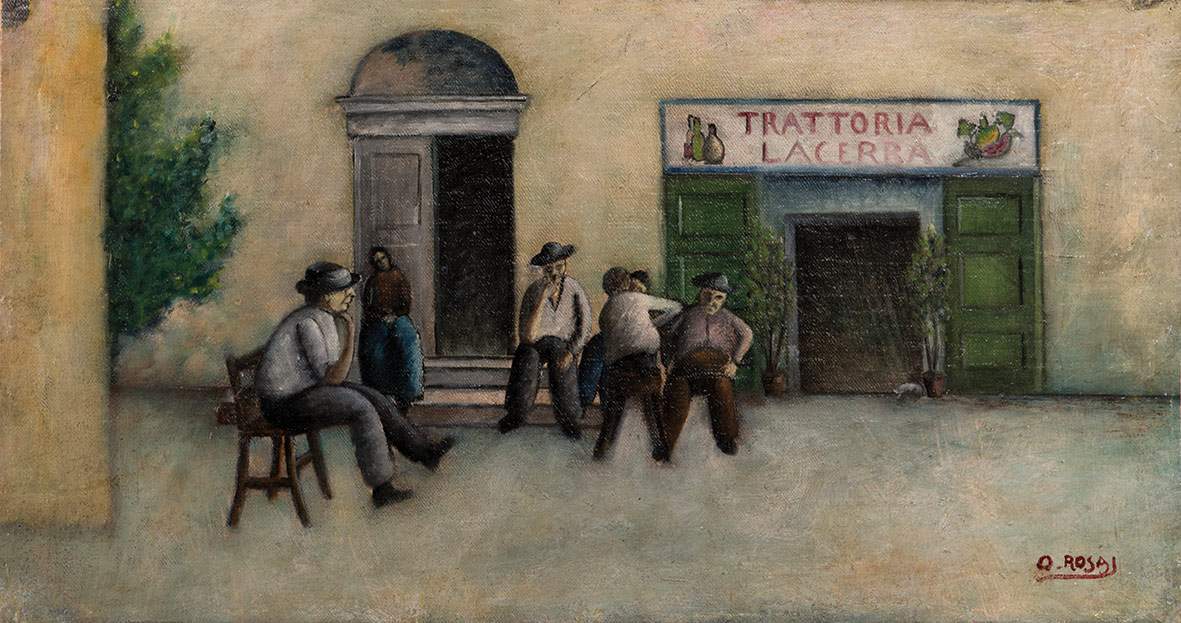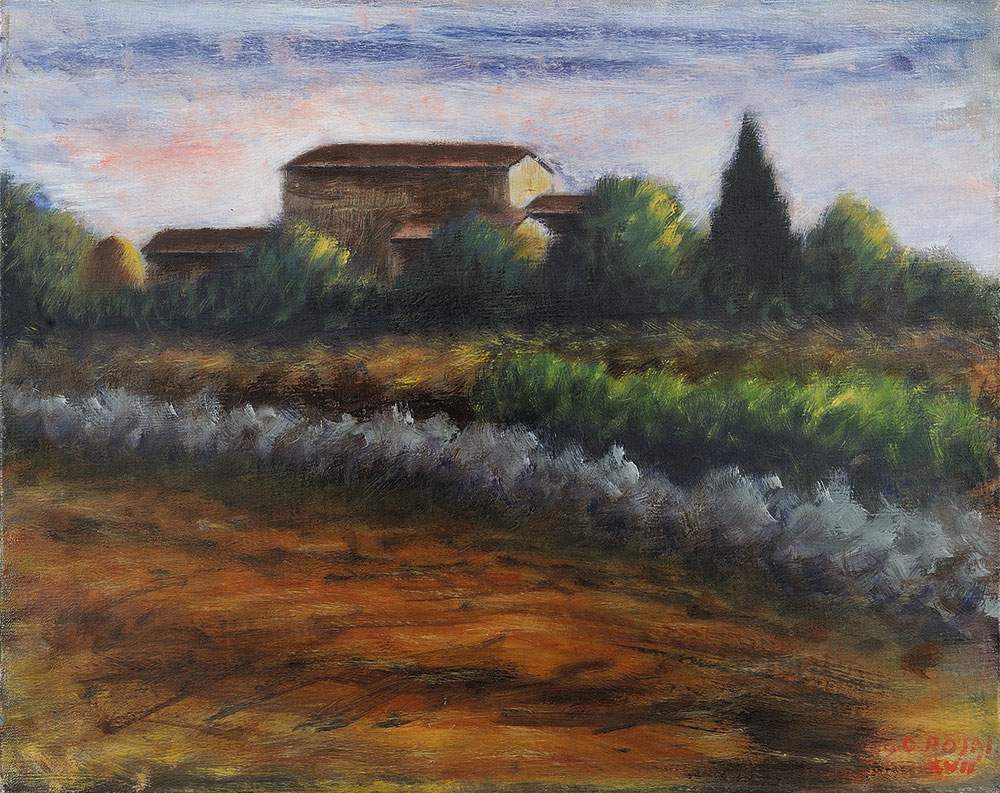Ottone Rosai (Florence, 1895 - Ivrea, 1957) was a painter whose art underwent several phases: he began his artistic career by being noticed by the Futurists and forming friendships in particular with Ardengo Soffici, but while inspired by the dictates of the movement, he would always maintain a very personal vision of art. In fact, his rebellious temperament by nature led him to reject conventions and often to take critical positions even in untolerant contexts such as Fascist Italy. The hierarchs, in response, spread the news of his homosexuality causing, to the mentality of the time, image damage to the painter, who ran for cover by marrying a childhood friend.
Also decisive in his life was the suicide of his father, so the young Rosai had to take over his business in order to provide stability for his family. This episode conditioned his tranquility, and this restlessness shines through in his paintings with their dark tones and chromatics, which lightened precisely when Rosai decided to devote himself full-time to painting. He painted mainly landscape scenes, still lif es and portraits of many of his friends, including famous names such as Soffici, Giorgio de Chirico and others.

Ottone Rosai was born in Florence on April 28, 1895 to an artisan father. He attended the Istituto d’Arte in his youth, and later enrolled in theAccademia di Belle Arti, but was expelled after a few years for misconduct. He continued his art studies as a self-taught artist, and at the same time came into contact with artists Giovanni Papini and Ardengo Soffici, who were part of the Futurist movement and introduced him to their artistic vision. He also met Filippo Tommaso Marinetti, the founder of Futurism, on the occasion of his first exhibition that took place in 1913 at the Pistoia bench, right next door to the venue where, at the same time, Lacerba’s exhibition L’esposizione di pittura futurista was being held. These are Rosai’s words about the meeting: “The exhibition was much visited, much discussed, and the greatest honor was to see the Futurists come there in a group. They looked, they talked, they admired, and finally Marinetti, head of the movement, expressed a desire to meet me. I was introduced to him by Papini and he in turn introduced me to Soffici, Carrà and Tavolato. They invited me with them and from that day on I became a Futurist militant and an unfailing frequenter of the Giubbe Rosse café.” However, Rosai was certainly inspired by the dictates of Futurist painting in his early works, but then followed his own personal point of view.
Soon afterwards he enlisted as a volunteer in the Royal Army, like many other Futurist artists, and was called to fight in World War I, from which he would return with two silver medals. Once the war was over, a difficult time opened up for Rosai because of the difficulties he encountered in rejoining society, and at this juncture he began to find the ideas of Benito Mussolini interesting. After the opening of a solo exhibition in Florence in 1920, another complicated period followed for Rosai. Two years later, in fact, a tragic episode occurred that would mark his existence, namely, his father decided to commit suicide, going so far as to make the extreme gesture by failing to clear his debts. Rosai from that moment inherited the burden of having to take care of the family and decided to take over his father’s carpentry business, so as to provide them with economic stability. He also worked in parallel until 1929 as an illustrator for some Fascist newspapers, Il Bargello and Il Frontespizio. To this period also dates the deterioration of relations with Ardengo Soffici, to whom he dedicated a caustic pamphlet entitled Alla ditta Soffici-Papini & compagni in 1931. In addition, a number of exhibitions, including a solo show held in Milan’s Il Milione gallery were unsuccessful, and so Rosai decided to give up painting for a year. He then devoted himself to writing, working first on his monograph for the Hoepli publishing house and then on the volume Dentro la guerra (Inside the War). This writing immediately had mixed fortunes, rejected in fact by the Ministry of Press and Propaganda, it instead attracted the attention of Giuseppe Ungaretti, who published it serially in his magazine Vita Nuova. The full version of the writing was later published in 1934 by the Novissima publishing house in Rome.
Beginning in 1931 he finally collaborated with the magazine L’Universale , which came into being precisely to disseminate his painting. In the same year he left his father’s carpentry business for good, devoting himself to painting full-time. In the meantime, the signing of the Lateran Pacts by Mussolini was a source of bitter disappointment for Rosai, as he felt that Fascism had betrayed the anticlerical positions of its early days, and this episode would lead him to write very harsh words towards this situation in the text Per lo svaticanamento dell’Italia . The volume caused a great stir among the Fascist hierarchies, which, wanting to respond to the harshness of the writing, began to spread the rumor of Rosai’s homosexuality as an infamous accusation, and this episode negatively affected his reputation. At that point Rosai in order to recover his image was forced to marry a childhood friend, who was aware of the painter’s habits and agreed to accept the marriage so as to protect him. The existential unease Rosai felt led him to choose to live in places far from civilization, and this torment became evident in the self-portraits of the period.
Not everything was gloomy in the painter’s life, however: in 1932 he reached consecration with a solo exhibition held at Palazzo Ferroni in Florence, which was followed by numerous other exhibitions in Milan, Rome and Venice. In 1939 he was appointed professor of figure drawing at the Liceo Artistico, and in 1942 he was given the chair of painting at the Accademia di belle arti in Florence. At the end of World War II, however, he again found himself plunged into despondency when the new ruling class demanded the removal from teaching of all those who were considered representatives of Fascism, totally ignoring the humiliating treatment the artist suffered precisely from the Fascists.
His exhibition activity, however, continued during the 1950s on an international level: he exhibited some of his works in New York, Cairo, Zurich, Paris, London, Madrid, and in Germany, where one of his exhibitions was revived in itinerant form. He was also given a solo exhibition, as a form of tribute, in Florence at the recently opened La Strozzina gallery in Palazzo Strozzi, and a major retrospective at the 1956 Venice Biennale. It was during a group exhibition in La Spezia that Rosai’s contemptuous character emerged when his paintings were not favorably judged in contrast to those of a younger painter, Gualtiero Passani, which were praised. Rosai was seized by a fit of rage and ruined one of his paintings by sticking a lit cigar in it, in addition to several insults against the art dealer accusing him of putting Passani’s paintings before his own. His health began to falter, and his heart was especially affected, being diagnosed with heart disease. Rosai continued to exhibit and receive tribute, however, and in fact in 1957 an exhibition dedicated to him was organized in Ivrea, in the Olivetti Cultural Center Rosai left for Ivrea to work on setting up the exhibition, but he suddenly died of a heart attack on May 13. His remains are in Florence in the Porte Sante cemetery.




Rosai was a painter characterized by a very personal and individual vision of art, and certainly his works were conditioned by the personal vicissitudes he faced in his life, so he favored humble subjects, from still lifes to portraits of family members to elderly people shrouded in a halo of sadness, accompanied by opaque hues that are also found in warmer colors such as yellow and red.
He is often juxtaposed with the Futurist group, and he actually came into contact with them around 1912, initially with works characterized by a rather strong brushstroke and intense colors, and then moving on to polymateric experiments by juxtaposing different materials together with color castings. Other paintings considered Futurists are dated to 1914, and they are Dynamism bar San Marco and a collage entitled Decomposition of a Street. In the same year, the Futurists invited Rosai to the Free Futurist Exhibition in the Sprovieri Gallery in Rome.
Ardengo Soffici, with whom Rosai used to hang out, was the conduit that led the painter to delve into Cubo-Futurism and collage and to get to know Paul Cézanne, Pablo Picasso and Henri Rousseau the Doganer. Nevertheless, Rosai maintained a certain individuality that led him to adhere early on to the figurative return, making his own a tendency that fully expressed his need to seek an autonomous language as much as possible, shunning conventions by nature. As early as 1913 he produced a black-and-white etching entitled The House of the Owls, which depicts a glimpse of houses with some poplars, rendered in rather dark and uneasy tones. In this case, the artist was influenced by the dramatic theater sets of Edward Gordon Craig, who was in Florence between 1908 and 1913. In 1919 he inaugurated a fervent period in which he produced first still lifes, then Tuscan landscapes and representations of figures in interiors rendered in a highly original way, achieving a simplification of volumes that is very similar to the full forms of Masaccio in the fifteenth century.
Thus materialized the complete return to figurativism, after a brief cubist phase that started from the study of reality as advocated by Soffici, who in the meantime had approached Mario Broglio’s Valori Plastici . In the solo exhibition dated 1920, previously mentioned in the biography and which was, moreover, introduced by Soffici himself, paintings made in that year appear: Serenata (or Concertino), Partita a Briscola and Giocatori di toppa, the first of a series of different versions. A few years later, Rosai took part in a trip to the Sienese countryside, and he brought back the sensations aroused by contact with this land in later paintings, which turn out to be very expressive: Suonatori (1928), a large version of Giocatori di toppa (1929), some urban views and various portraits.
In this lively return to figurativism, the uniqueness of the human figures in Rosai’s works lies in the fact that the features resumed typical Tuscan traits, and they were depicted spending time at the tavern among the humblest alleys of Florence, representing a timeless humanity. They were painted in a realistic and essential way, using earthy colors. In 1931 there is more luminosity in the colors of Rosai’s works, and the overall tones also lighten. This period coincides with his decision to devote himself totally to painting, abandoning his carpentry work. Between 1935 and 1938, Rosai produced even more subdued works, including the two panels he made for the refreshment room of the Florence station, entitled Tuscan Landscapes. The influence of World War II, which caused him further discouragement and distrust in the future having already experienced the first, was felt in his postwar works, in which the figures appear much more dramatic and sharply detached from neutral backdrops by marked outlines.




Rosai’s works can be found in Italy. In Florence, the painter’s birthplace, his work Piazza del Carmine (1954) is preserved in the Palazzo Pitti, while the Museo del Novecento houses a bequest consisting of a large number of works, donated by his widow Francesca Fei in 1963, which includes numerous views of Florence and especially portraits of famous personalities, the so-called “Amici series,” all made between 1954 and 1955. Portraits include Eugenio Montale, Elio Vittorini, Giorgio de Chirico, Ardengo Soffici and Romano Bilenchi.
Other works can be seen in Forlì, at the Palazzo del Novecento, where I muratori (1949) is located; in Pieve di Cento (Bologna) at the Museo MAGI ’900 (Museum of Art of Italian Generations of the ’900) where two versions of Christ on the Cross are preserved, one undated and one dating from 1948; in Macerata at the Palazzo Ricci, where they are The Blind Man (1932), Tuscan Landscape (1950), Man Reading (1950s), Vase of Tulips (1956), and Players at the Café (1956).
 |
| Ottone Rosai, life and works of the artist close to the Futurists |
Warning: the translation into English of the original Italian article was created using automatic tools. We undertake to review all articles, but we do not guarantee the total absence of inaccuracies in the translation due to the program. You can find the original by clicking on the ITA button. If you find any mistake,please contact us.